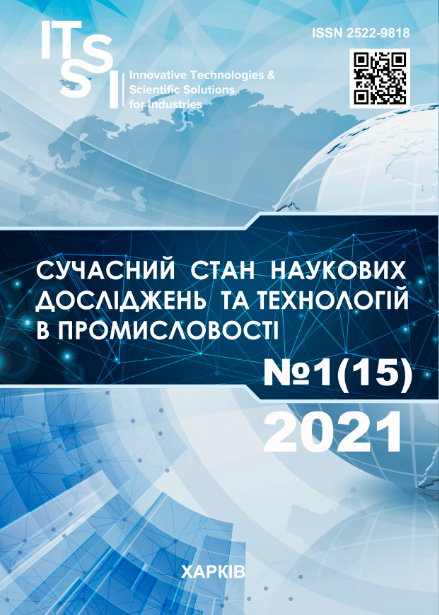ТЕХНОЛОГІЯ СТВОРЕННЯ ТОПОЛОГІЇ ДРУКОВАНИХ ПЛАТ ЗА ДОПОМОГОЮ ПОЛІМЕРНИХ 3D МАСОК
DOI:
https://doi.org/10.30837/ITSSI.2021.15.120Ключові слова:
друковані плати, експонування, полімерні фотомаски, розчини для травлення, LCD друк, регресійний аналіз, топологія, адаптація зображення провідниківАнотація
Предметом дослідження є вплив факторів експонування двовимірних зображень на топологію провідників при виготовленні друкованих плат методом тривимірних полімерних фотомасок. Мета роботи – забезпечення точності та збереження геометричних розмірів провідників друкованих плат при LCD експонуванні масок на заготовку. Для досягнення поставленої мети необхідно вирішити наступні завдання: проаналізувати технологію фотолітографії та види полімерного 3D друку; розробити технологічний процес експонування фотополімерних масок на заготовку друкованої плати, використовуючи технології 3D друку; провести експериментальні дослідження для визначення оптимальних параметрів експонування; на основі отриманих емпіричних результатів розрахувати коефіцієнти кореляції факторів на відгук; побудувати лінійну регресійну модель залежності відхилень геометричних розмірів друкованих провідників від параметрів розчинів для травлення і умов експонування. Результати: побудовані регресійні моделі дають можливість спрогнозувати вплив технологічних параметрів експонування на точнісні показники геометричних розмірів топології провідників друкованих плат при 3D масочному виготовленні при LCD експонуванні, оптимізуючого вихідні зображення топології друкованих провідників при автоматизованому виробництві друкованих плат. Це спростить процес розробки топології друкованих плат з урахуванням реального впливу параметрів технологічних операцій травлення і експонування на товщину доріжок провідників друкованих плат, що зменшить частку браку при виготовленні односторонніх та двосторонніх друкованих плат. Висновки: запропонована технологія LCD експонування та метод дослідження впливів факторів експонування на якість топології друкованих плат, які дають достатні емпіричні данні для створення регресійних моделей розрахунку впливу технологічних факторів на кінцеві розміри провідникових доріжок при виробництві друкованих плат. Подальший розвиток запропонованої технології дозволить виготовляти жорсткі та гнучкі ДП повністю, зі струмопровідними доріжками, діелектричною основою, радіоелектронними елементами, які можуть застосовуватися в різних пристроях.
Посилання
Nevliudov, I., Razumov-Fryziuk, Ye. A., Nevliudova, V., Demska, N. (2016), "Influence mechanical action on flexible printed circuit board", Problems of Friction & Wear, Vol. 1(70), P. 143–149. DOI: 10.18372/0370-2197.1(70).10402
Nevliudov, I. Sh., Tymchuk, I. T., Protsenko, M. A., Demska, N. P. (2018), "The advanced design and technological solutions of ultralight detector modules for physical experiments", Innovative Technologies and Scientific Solutions for Industries, Vol. 3 (5), P. 67–78. DOI: https://doi.org/10.30837/2522-9818.2018.5.067
Vaezi, M., Seitz, H., Yang, S. (2013), "A review on 3D micro-additive manufacturing technologies", The International Journal of Advanced Manufacturing Technology, Vol. 67 (5-8), P. 1721–1754. DOI: https://doi.org/10.1007/s00170-012-4605-2
Pan, Y., Chen, Y. (2016), "Meniscus process optimization for smooth surface fabrication in Stereolithography", Additive Manufacturing, Vol. 12, Part B, P. 321–333. DOI:10.1016/j. addma.2016.05.004
Kumar, S., Bhushan, P., Pandey, M., Bhattacharya, S. (2019), "Additive manufacturing as an emerging technology for fabrication of microelectromechanical systems (MEMS)", Journal of Micromanufacturing, Vol. 2 (2), P. 175–197. DOI: https://doi.org/10.1177/2516598419843688
Mohammed, J. S. (2016), "Applications of 3D printing technologies in oceanography", Methods in Oceanography, Vol. 17, P. 97–117. DOI: 10.1016/j.mio.2016.08.001
"SL/SLA (stereolithography)" ["SL/SLA (stereolytohrafyia)"], available at : https://www.jetcom-3d.ru/technology/stereolithography (last accessed 03.11.2020).
Manapat, J. Z., Chen, Q., Ye, P., & Advincula, R. C. (2017), "3D printing of polymer nanocomposites via stereolithography", Macromolecular Materials and Engineering, Vol. 302 (9), P. 1600553. DOI: https://doi.org/10.1002/mame.201600553
"DLP (Digital Light Processing)" ["DLP (Digital Light Processing"], available at : https://www.jetcom-3d.ru/technology/digital-light-processing (last accessed 03.11.2020).
Jacobsen, A., Jorgensen, T., Tafjord, Kirkhorn, E. (2015), "Concepts for 3D print productivity systems with advanced DLP photoheads", In Emerging Digital Micromirror Device Based Systems and Applications VII, International Society for Optics and Photonics, Vol. 9376, P. 937605. DOI: https://doi.org/10.1117/12.2084962
"Modern photopolymer printers 3D printers: laser, DLP, LCD" ["Sovremennыe fotopolymernыe prynterы 3D-pryntery: lazernye, DLP, LCD"] available at : https://3dtoday.ru/blogs/pl32/modern-photopolymer-3d-printersprinters-laser-dlp-lcd (last accessed 05.11.2020).
Shen, J. Y. H., & Tan, Z. X. (1999), "Curing characteristics of acrylic photopolymer used in stereolithography process", Rapid Prototyping Journal, Vol. 5 (1), P. 27–34. DOI: https://doi.org/10.1108/13552549910251855
Andrzejewska, E. (2001), "Photopolymerization kinetics of multifunctional monomers", Progress in Polymer Science, Vol. 26, No. 4, P. 605–665. DOI: 10.1016/S0079-6700(01)00004-1
Huang, Y.-M., Kuriyama, S., Jiang, C.-P. (2004), "Fundamental study and theoretical analysis in a constrained-surface stereolithography system", The International Journal of Advanced Manufacturing Technology, Vol. 24, No. 5-6, P. 361–369. DOI: 10.1007/s00170-003-1627-9
Dubnov, P. Yu. (2004), Processing statistical information using SPSS [Obrabotka statystycheskoi ynformatsyy s pomoshchiu SPSS], Moscow : NT Press, 221 p.
##submission.downloads##
Опубліковано
Як цитувати
Номер
Розділ
Ліцензія

Ця робота ліцензується відповідно до Creative Commons Attribution-NonCommercial-ShareAlike 4.0 International License.
Наше видання використовує положення про авторські права Creative Commons для журналів відкритого доступу.
Автори, які публікуються у цьому журналі, погоджуються з наступними умовами:
Автори залишають за собою право на авторство своєї роботи та передають журналу право першої публікації цієї роботи на умовах ліцензії Creative Commons Attribution-NonCommercial-ShareAlike 4.0 International License (CC BY-NC-SA 4.0), котра дозволяє іншим особам вільно розповсюджувати опубліковану роботу з обов'язковим посиланням на авторів оригінальної роботи та першу публікацію роботи у цьому журналі.
Автори мають право укладати самостійні додаткові угоди щодо не комерційного та не ексклюзивного розповсюдження роботи у тому вигляді, в якому вона була опублікована цим журналом (наприклад, розміщувати роботу в електронному сховищі установи або публікувати у складі монографії), за умови збереження посилання на першу публікацію роботи у цьому журналі.
Політика журналу дозволяє і заохочує розміщення авторами в мережі Інтернет (наприклад, у сховищах установ або на особистих веб-сайтах) рукопису опублікованої роботи, оскільки це сприяє виникненню продуктивної наукової дискусії та позитивно позначається на оперативності та динаміці цитування опублікованої роботи.














